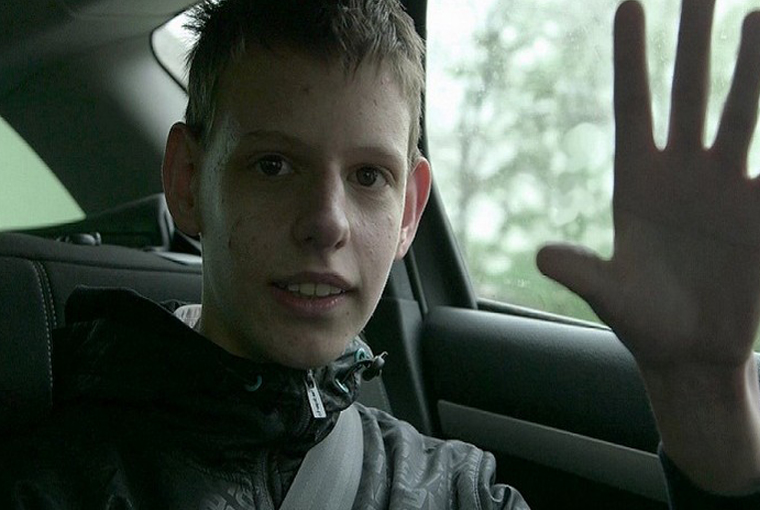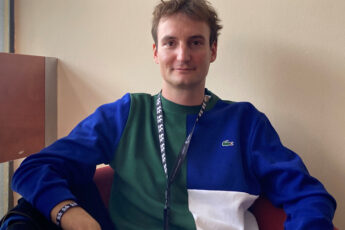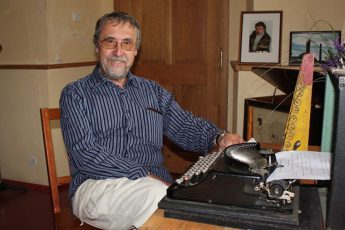Normalizing Autism
Miroslav Janek’s Normal Autistic Film (Normální autistický film, 2016)
Vol. 67 (September 2016) by Patricia Bass
We are disabled to each other, I and society,” depressed and autistic 17-year-old Majda says.1 She sits poker-faced in a train while the Czech countryside rolls past. Majda harbors a deep hostility towards the family, school and world that don’t understand her. She resents that she was only provided a diagnosis explaining her alienation in her early teens, and only at her own request. But her experience only constitutes one of five distinct “takes” on living with autism in Miroslav Janek’s intelligent and provocative documentary, Normal Autistic Film (2016).
Janek follows five young people (from primary school children to adolescents) who all share the diagnosis of Asperger’s syndrome, a high-functioning condition on the autism spectrum. Whereas autism is generally characterized by impaired social skills, repetitive actions, and difficulty dealing with or understanding change, those with Asperger’s rarely have the impaired mental capacities or lack of language common to other autistic subjects. Thanks to this distinction, Janek’s subjects – even if they are not capable of speaking to the camera – can express their experiences in their own words, which Janek gives them free reign to do.
Lukas, a bright, talkative, and droll early adolescent introduces the film and plays a role in its crew.2 He speaks directly to the camera, mostly in monologue about himself and his projects (as most individuals with Asperger’s have tendency to do), and flits around his attic bedroom, inadvertently flapping his arms with each step.
Lukas is fascinating for his matter-of-fact acceptance of his own peculiarities. At one point, the camera shows him voraciously biting off and eating pieces of a large block of Styrofoam. Janek asks Lukas if he’s concerned that such footage will cause people to think that autistic people eat Styrofoam, and Lukas responds very simply that he needs to constantly chew on things to relieve stress, which incidentally also causes him to drool all the time. He points to a scar on his chin from excessive drooling as proof. Later, Lukas is shown handling a large firearm, and – equally matter-of-factly – he states that this footage will probably make the film’s audience scared of an autistic adolescent doing a school shooting. Lukas attributes his difficulty befriending classmates, and his problem of seeming aggressive at school, to his syndrome. That said, he has one friend: a painfully hip, neurotypical preteen who he makes amateur films with.
Shortly after introducing Lukas, Janek turns his focus to Denis, whose talented classical piano playing accompanies much of the film. Denis, another adolescent, is less socially skilled than Lukas, and seems to spend much of his time lost in his own thoughts, but his piano skills – and baritone singing – are extraordinary. Like most of the other subjects, Denis is able to recognize his neurodivergency and speak of his experience: he is happy to be “a little weird”.
We also meet Marjamka, an extremely bright girl of twelve who constantly speaks to herself in fluent English, although her native language is Czech. She spends her days drawing fairies, living and explaining her fairy world (which she calls a “dimension”), and angrily resisting doing her homework. Her brother, Ahmed, is also on the autism spectrum. At a particularly touching moment in the film, they crawl over living room couches and Janek (who is shown only in this shot), spouting prodigious theories of how alien intelligence was passed on to autistic children. Later, interviews with Marjamka and Ahmed’s mother allows us to understand how popular stereotypes, self-education, and even racism play a role in parenting neurodivergent children.
Finally, there is Majda, perhaps the most alarming and elusive of Janek’s subjects. Like Denis and Ahmed, Majda never speaks in the presence of the camera, but her violent and hostile poetry, transposed over aggressive rap beats, expresses her thoughts. Although most teenagers express, at some time or another, that they want to kill themselves, they feel stupid, and that the world around them makes them miserable, the repetition in Majda’s poetry and the lack of any other information provided about her makes hostility and alienation her defining traits. Then again, her anger is not misplaced: “Most people aren’t friends, they compete”, she says. It’s a dour observation, but spot-on. This provides a valuable balance to Lukas’s goofy and earnest acceptance of his neurodiversity and Denis’s blissful zen.
By filming such a range of subjects, Janek succeeds in presenting autism as a spectrum of diverse experiences. One could argue that this is not representative of autism as a whole, since all of the subjects identify as “aspies”- the children’s term for themselves and others with Asperger’s Syndrome. Yet this choice enriches the film more than it limits it. Producer Jan Macola of Mimesis Films notes that other candidates were considered and that another, lower-functioning, autistic subject may be granted a “separate 30 minute film at the end.” In the end, Macola suggests, Janek chose these five for “coherence”. Focusing on those with Asperger’s also highlights the fact that even within a subcategory of autism, a diversity of experience reigns. Moreover, the subjects’ ability for perceptive self-reflection and expression of their thoughts allows for the most fascinating scenes and observations of the documentary.
Otherwise, the jarring and intense soundtrack mirrors the overstimulating sensory experience of autistic people, and the director’s focus on his subjects’ words, feelings, and activities – as opposed to their doctors’ or caretakers’ narratives – prioritizes and legitimates the neurodiverse experience. And thus, as the press release states, “instead of looking at autism as a diagnosis, the film shows it as a magic and mysterious way of thinking.”
This, in itself, is valuable. Janek’s project of normalizing the autistic experience, which is evident from the very title of the film, pushes back against the common castigation of parents of autistic children and broad-brushed generalizations made about “autism”. His project aligns with movements in the autistic community towards self-advocacy3 and in academia, towards Disability Studies. According to the latter, “disability” and even “pathology” are historically and culturally contingent constructs.
The film’s good intentions contain a very slight, but somewhat troubling, contradiction. Striving to normalize autism, it still “shows it as a magic and mysterious way of thinking” (my emphasis). If the subjects were truly considered “normal”, they would not be followed by a camera crew and interrogated on how they see the world. Normal Autistic Film leaves a small after-taste of voyeurism and fetishism, which blunts its message.
I attribute this aftertaste to the structure of the film. It is improbable that the film’s crew included anyone on the autistic spectrum, besides Lukas. The audience is also clearly assumed to be neurotypical; the press release claims that autistic people “may bring us “neurotypical ones” some message” (my emphasis). The film’s objective is to provide “us” with a privileged glimpse of the exotic world of the “others”.
A counterexample to this is the 2006 Normal People Scare Me, a documentary film about autism co-directed by Taylor Cross and Keri Bowers. Like Normal Autistic Film, Normal People Scare Me is composed of interviews with autistic children and aimed at enlightening a neurotypical audience. Unlike Janek’s film, however, Normal People Scare Me was instigated and directed by an autistic teenager (Cross) and his mother (Bowers). Cross conducts the interviews and was mentored by Joey Travolta, brother of John and a former special education teacher, on lighting, camerawork, and editing. This year, Joey Travolta’s Inclusion Films is releasing a sequel, Normal People Scare Me Too, with a film crew that is composed entirely of individuals on the autism spectrum. According to an interview4 with Keri Bower by Debra Mazokar, the sequel will include more female subjects, and lower-functioning autistic people who may be non-verbal, dually-diagnosed or self-injurious.
The camerawork, composition, and style of Janek’s film is certainly more beautiful and compelling than Normal People for this, non-autistic, film critic. And in the end, both achieve the goal of rendering the autistic experience as normal and diverse. Although Janek’s more recent film may not directly provide a “voice” for those interviewed – since they are still mediated by the director and (largely non-autistic) film crew – its artistic value creates a bridge between art and social activism, between autistic children in the Czech Republic and international film audiences, and the neurodivergent and the neurotypical. Maybe it even calls for a reminder that none of these categories were mutually exclusive to begin with.




Leave a Comment